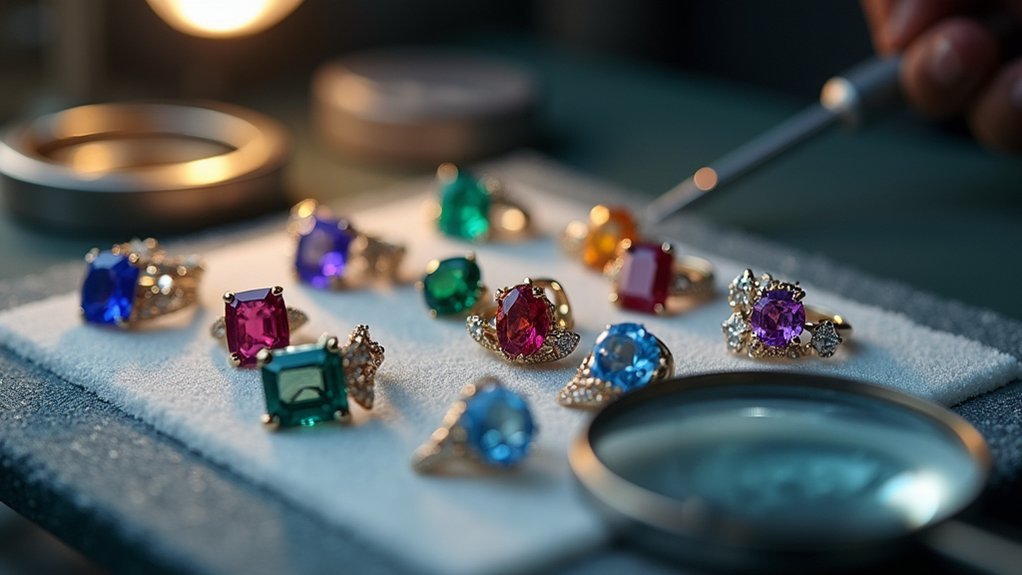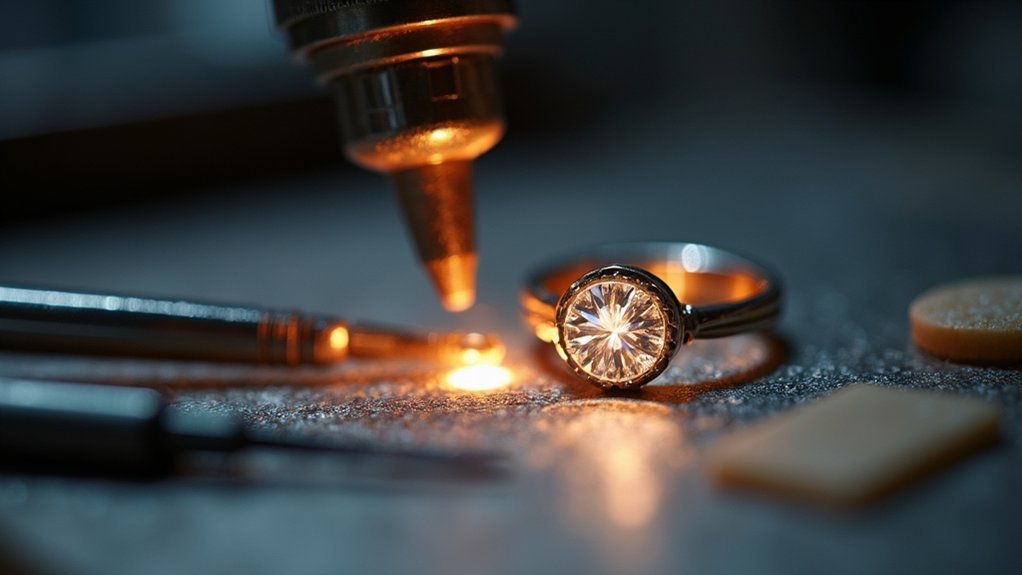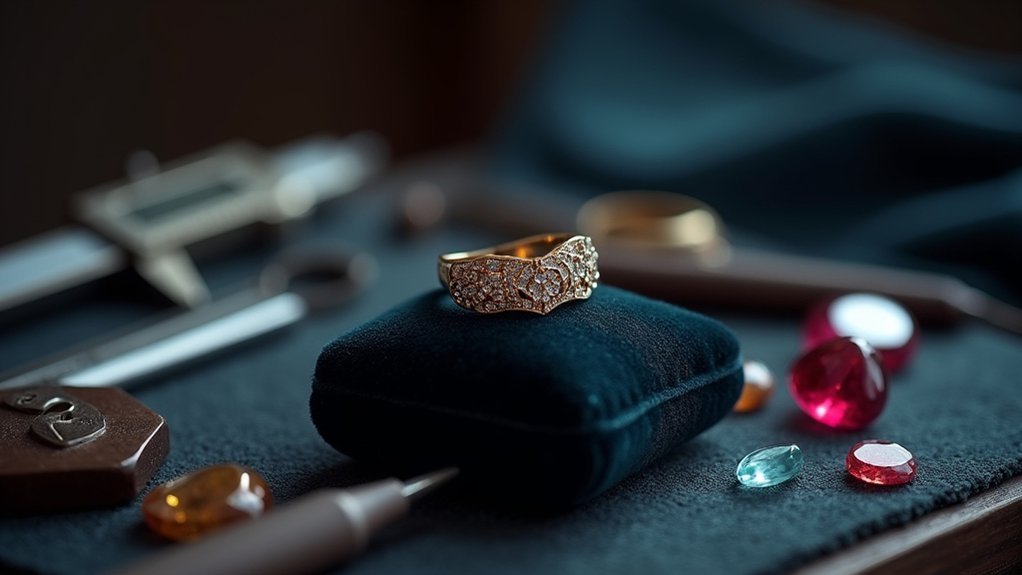You’ll protect gemstones during ring resizing by using thermal putty and insulating paste around heat-sensitive stones like opals and emeralds. Apply cushioned clamps to distribute pressure evenly and use microtorches for precise heating control. Consider heat-free methods like mechanical stretching with Schwaan Ring Stretchers for delicate pieces. Remove stones from pavé or channel settings when necessary, and always inspect stone security after resizing. Master these techniques to discover advanced laser soldering methods.
Understanding Stone Vulnerability During Ring Resizing

Precision becomes your greatest ally when resizing rings with gemstones, as different stones react uniquely to the heat and pressure involved in the process.
Heat-sensitive stones like opals and emeralds demand extra caution during ring resizing, requiring quick heating with small flames to minimize exposure time.
You’ll find that certain stone settings present greater challenges than others.
Pavé and channel settings often loosen during adjustments, while tension-set rings can’t be resized without compromising the stone’s security entirely. To secure gemstones effectively, you must assess each ring individually before proceeding.
Protecting stones from thermal shock requires strategic use of insulating materials like water or specialized paste around vulnerable areas, ensuring your resizing work maintains both structural integrity and gemstone stability.
Essential Protective Tools and Equipment for Stone Safety
You’ll need the right protective tools and equipment to safeguard stones during ring resizing operations.
Heat insulation materials like ceramic blocks and water-filled containers form your first line of defense against thermal damage.
Specialized soldering equipment with precise flame control and dedicated stone removal tools complete your essential safety arsenal.
Heat Insulation Materials
When working with heat-sensitive gemstones during ring resizing, you’ll need reliable insulating materials to create protective barriers between your soldering equipment and delicate stones.
Thermal putty stands out as an excellent choice, forming moldable protection around gems during the soldering process. You can also use ceramic covers or apply insulating paste strategically to shield heat-sensitive stones from excessive temperatures.
Water-filled boxes provide another effective method, absorbing heat before it reaches vulnerable gemstones. These insulating materials work together to preserve gemstone integrity throughout your work.
After completing repairs, implement proper air cooling techniques to prevent thermal shock. Always monitor your insulation’s effectiveness with regular checks, ensuring no heat has compromised your stones’ safety during the resizing process.
Specialized Soldering Equipment
While protective materials shield your gemstones from heat damage, the specialized soldering equipment you choose determines how precisely you can control that heat in the first place. A microtorch provides the precise heating control essential for working around heat-sensitive stones during ring resizing.
You’ll need to use a small, concentrated flame that heats quickly and minimizes heat transfer to vulnerable gemstones. This targeted approach prevents thermal shock that could crack or damage your stones.
Throughout the soldering process, you must monitor temperature carefully and work efficiently to avoid overheating. Once you’ve completed the resize, implement air cooling techniques to gradually reduce temperatures.
Regular equipment checks guarantee you’re maintaining the integrity of the ring while protecting delicate gemstones from unnecessary thermal stress.
Stone Removal Tools
Precision becomes paramount when you’re working with gemstone-set rings that require stone removal before resizing. Resizing can often damage precious stones without proper protective equipment.
You’ll need specialized tools that safeguard gemstones throughout the entire process.
Essential stone removal tools include:
- Ring-cutting pliers – Enable clean cuts while minimizing stress on mounted stones during initial removal steps.
- Gemstone protection pliers – Secure stones firmly in place and reduce chipping risks during handling.
- Heat-resistant insulation – Protects temperature-sensitive gems using insulating paste or water-filled protective boxes.
- Stone-set ring enlarger – Allows precise adjustments without compromising stone settings or security.
These tools work together with careful soldering techniques to guarantee your stone-set rings maintain their integrity.
Proper equipment investment prevents costly gemstone damage and guarantees professional resizing results.
Heat-Free Resizing Methods to Protect Gemstones
Since many precious gemstones can crack or lose their luster when exposed to high temperatures, you’ll need heat-free resizing methods to protect your valuable stones.
Mechanical stretching offers excellent stone protection when resizing a ring, allowing you to enlarge bands without damaging temperature exposure.
The Schwaan Ring Stretcher provides effective results by gradually stretching rings without direct stone contact.
For compression work, specialized machines apply controlled pressure to reduce plain band sizes while minimizing gemstone risk.
When dealing with delicate settings, you can use ring-cutting pliers and jewelers saws to remove bands before resizing, ensuring complete stone safety.
Cold water and soap also help remove swollen rings without cutting, particularly useful for heat-sensitive stones requiring gentle handling throughout the process.
Laser Soldering Techniques for Delicate Stone Settings

When you’re resizing rings with heat-sensitive gemstones, laser soldering offers unmatched precision that protects your valuable stones from thermal damage.
You’ll find this technique allows for exact heat control, directing energy only where it’s needed while keeping surrounding areas cool.
This method proves especially valuable when you’re working with delicate settings that can’t withstand traditional high-heat soldering processes.
Laser Precision Stone Safety
Although traditional torch soldering can send heat throughout an entire ring and potentially damage delicate gemstones, laser soldering techniques offer you pinpoint control that revolutionizes how jewelers approach resizing rings with sensitive stone settings.
Laser precision enables targeted heating that protects your heat-sensitive gemstones while ensuring successful jewelry repair. This advanced technology transforms how professionals resize rings by focusing exclusively on metal areas requiring modification.
Key advantages include:
- Temperature Control – You’ll achieve exact heating temperatures without affecting surrounding stones
- Minimal Heat Transfer – Laser beams concentrate energy precisely where needed
- Faster Cooling – Quick cooling prevents thermal shock to gemstones
- Stronger Bonds – Minimal metal intrusion preserves ring integrity
These resizing techniques allow complex stone protection in pave and channel settings while maintaining your ring’s original aesthetics and structural strength.
Heat Control During Soldering
While precision remains essential throughout any resizing project, you’ll find that mastering heat control during laser soldering separates amateur attempts from professional results when working with delicate stone settings.
You’ll minimize heat exposure by utilizing quick heating and cooling cycles, preventing thermal shock that can crack vulnerable gems. Focus your laser beam precisely on target areas, avoiding unnecessary contact with surrounding stone settings.
You’ll maintain better control by adjusting power levels based on metal type—platinum requires different settings than gold. Use insulating shields to protect nearby gems from residual heat.
This controlled approach prevents loosening of stones while creating strong bonds. Master these heat control techniques, and your ring resizing projects will consistently preserve both structural integrity and gemstone beauty.
Protecting Vulnerable Gem Settings
Building on proper heat management, protecting vulnerable gem settings requires strategic placement of insulating barriers and careful assessment of each stone’s heat tolerance.
Laser soldering provides the precision needed when resizing rings with delicate gemstone settings, minimizing thermal shock risks that traditional methods can’t avoid.
Master jewelers employ these protective techniques:
- Water-filled containment boxes – Surround heat-sensitive stones with cooling barriers
- Insulating paste application – Create thermal shields around vulnerable settings
- Quick heating cycles – Reduce overall heat exposure time through laser precision
- Setting vulnerability assessment – Evaluate each stone’s specific heat tolerance before beginning
This approach creates strong bonds while maintaining your ring’s original design integrity.
The laser’s controlled heat application prevents excessive temperature transfer that could loosen or crack your precious stones during the resizing process.
Cushioned Clamps and Protective Sleeve Applications

Two essential tools stand between your precious gemstones and potential damage during ring resizing: cushioned clamps and protective sleeves.
Cushioned clamps distribute pressure evenly across the ring, preventing stones from loosening or breaking during the resizing process. You’ll want to position these clamps carefully to provide maximum support without applying excessive force to delicate settings.
Proper clamp positioning ensures even pressure distribution, safeguarding gemstones from damage while providing essential support during ring resizing procedures.
Protective sleeves shield your gemstones from heat and physical stress during soldering operations. Apply these sleeves before any heat-intensive work to prevent thermal shock damage.
You can also use insulating materials like water or specialized paste around heat-sensitive stones for additional protection. When you implement both cushioned clamps and protective sleeves together, you’ll greatly enhance gemstone safety while maintaining their integrity and appearance throughout the entire resizing procedure.
Insulation Materials and Thermal Protection Strategies
When heat becomes your enemy during ring resizing, strategic insulation materials form your primary defense against gemstone damage.
You’ll need proper thermal protection to safeguard precious stones throughout the resizing process.
Essential heat protection methods include:
- Insulating paste or heat-resistant putty – Apply directly around gemstones to create a protective barrier during soldering.
- Water submersion technique – Keep stones submerged in a water-filled box while heating the metal portions.
- Quick flame application – Use small, hot flames for rapid heating that minimizes heat transfer to sensitive areas.
- Air cooling protocols – Allow repairs to cool naturally rather than forcing rapid temperature changes.
Master these soldering techniques while conducting regular temperature checks.
You’ll prevent overheating and maintain your gemstone’s integrity.
Effective thermal protection isn’t optional—it’s essential for preventing costly heat damage during professional resizing work.
Stone Removal Considerations for Complex Resizing Jobs

Despite your best thermal protection efforts, some complex resizing jobs require complete stone removal to confirm safety and precision.
You’ll need to remove gemstones from pave or channel settings where stones can easily become loose during the cutting and soldering process. Tension-set rings demand particular attention since altering the band compromises the tension mechanism that secures the stone, making professional stone removal essential.
Heat-sensitive stones like opals and pearls must be removed regardless of your thermal protection setup, as they’re vulnerable to thermal shock and cracking from soldering temperatures.
Opals and pearls require removal before any heat work due to their extreme sensitivity to thermal shock and cracking.
Complex settings with multiple small stones or intricate metalwork won’t withstand resizing forces without risk.
After completing the resizing work, you’ll need to thoroughly inspect all stone settings before reinstalling gemstones to confirm they’re secure and undamaged.
Temperature Management During Traditional Soldering
Three critical temperature control factors determine your success when soldering rings with gemstones in place. Proper temperature management protects valuable stones while guaranteeing strong solder joints.
Your flame technique directly impacts heat transfer control. Use a small, concentrated flame for quick heating, which minimizes thermal exposure to surrounding gemstones. Monitor thicker shanks carefully since they conduct heat more rapidly than thin metals.
Essential temperature management strategies include:
- Deploy insulating materials like water-filled boxes or protective paste around gemstones
- Implement air cooling immediately after soldering to prevent thermal shock
- Conduct regular integrity checks during the process to avoid overheating
- Adjust flame intensity based on metal thickness and stone sensitivity
These techniques guarantee your gemstones remain undamaged throughout the soldering process.
Quality Assurance and Post-Resizing Stone Inspection

After completing your ring resizing, you must conduct a thorough gemstone inspection to verify that every stone remains secure and undamaged.
Pay special attention to pave and channel stone settings, as they’re particularly susceptible to loosening during the resizing process. Check heat-sensitive stones like opals and pearls for any signs of thermal damage, including cracks or discoloration that may have occurred despite protective measures.
Test each stone’s security by gently pressing around the settings to guarantee proper tension.
Clean and polish the ring carefully to restore its original luster while inspecting for potential setting issues. This quality assurance step is essential before returning the ring to your customer, as it confirms that both the structural integrity and aesthetic appeal have been maintained throughout the gemstones’ protection during resizing.
Frequently Asked Questions
Can Rings With Stones Be Resized?
You can resize rings with stones, but it depends on the setting type. Prong-set stones are generally safe, while channel-set, pave-set, and invisible-set stones present greater risks and limitations.
How Do You Keep Stones From Falling Out of Rings?
You’ll prevent stones from falling out by regularly inspecting prong settings, having loose prongs retightened professionally, avoiding harsh impacts, and getting annual jewelry maintenance checks to guarantee settings remain secure.
What Are the Risks of Ring Resizing?
You’ll face structural weakening from cutting and soldering processes. Heat-sensitive stones can crack or loosen, intricate settings may destabilize, and thin bands risk damage. Frequent resizing compounds these risks considerably.
How Do You Make a Ring Smaller Without Damaging It?
You’ll cut out a small band section and solder it back together. First, consult a jeweler to assess risks, remove heat-sensitive stones, and use protective techniques during soldering for seamless results.
In Summary
You’ve learned the critical techniques for protecting stones during ring resizing. Remember, you can’t rush this process—proper preparation and the right tools make all the difference. Whether you’re using heat-free methods, laser soldering, or traditional techniques, always prioritize stone safety over speed. Don’t forget to inspect thoroughly afterward. With practice and patience, you’ll master these protective methods and deliver flawless results every time.





Leave a Reply